NIWA are studying the ocean off Tairāwhiti and Hawke’s Bay to see how Cyclone Gabrielle has impacted the health of fisheries habitats and seabed ecosystems.
Cyclones can cause huge changes to the ocean environment through the influx of silt from the land via rivers, increased ocean mixing, and re-suspension of sediments from the seafloor.
Project leader Dr Daniel Leduc says the cyclone caused considerable damage to land and property, but effects on the ocean are harder to gauge.
“One of the most shocking sights from Cyclone Gabrielle was those huge sediment deposits that buried houses to their rooftops. The home of our marine life is also impacted, only it is harder to map and is constantly moved around by water currents, waves, and tides.
“Our job is to assess where the impacts have been felt and to what extent, particularly in vulnerable habitats and places where species like flounder and gurnard live close to the seafloor,” said Dr Leduc.
A key output of this work is to develop models which will help determine where this sediment has ended up. This involves analysis of sediment using tools like satellite imagery, but also through several sea voyages throughout the year to collect samples of the sediment, obtain video footage of the seafloor, and map it using soundwaves.
In April, NIWA completed 13 days of multibeam sonar mapping of the seafloor to look for cyclone-induced sediment deposits, which they compared with previous mapping. This was followed by a 19-day voyage in June where they captured additional video footage and took samples through sediment coring.
Dr Leduc says the crew observed encouraging signs of life in the seafloor sediment cores, such as sand dollars, hermit crabs, juvenile shellfish, and sea cucumbers.
"These are important parts of the food web, and their presence could either mean that they were able to survive the increased sediment or that the sediment did not collect in these areas.”
Dr Joshu Mountjoy, a NIWA marine geologist who specialises in seafloor mapping, says areas of the seafloor have been affected differently with many areas needing further investigation.
“The Wairoa Hard, which hosts an important nursery for juvenile fish, showed no large-scale sediment build-up when we mapped the area in April. However, sediment cores taken in June had high mud contents that could be cyclone related. In addition, when the team conducted research trawls in June, they returned little biology, but lots of wood debris,” said Dr Mountjoy.
Fisheries New Zealand commissioned NIWA to conduct this research and will use the information to help understand implications of the Cyclone on local fisheries.
Dr Leduc said that how the ecosystem may have been impacted is unclear.
“The water has been too murky to get any good images of the seafloor, but this area will be followed up again this year to gain more insights,” said Dr Leduc.
Director Science & Information Simon Lawrence says the research provides a baseline to help inform how we manage these fisheries.
“It is important to understand what is happening beneath the water now so that we can make good decisions about it for the future. While the NIWA team analyse these initial findings, a third voyage is planned for October to see how things have progressed,” said Mr Lawrence.
- More News
- Learn more about NIWA cyclone-related projects



